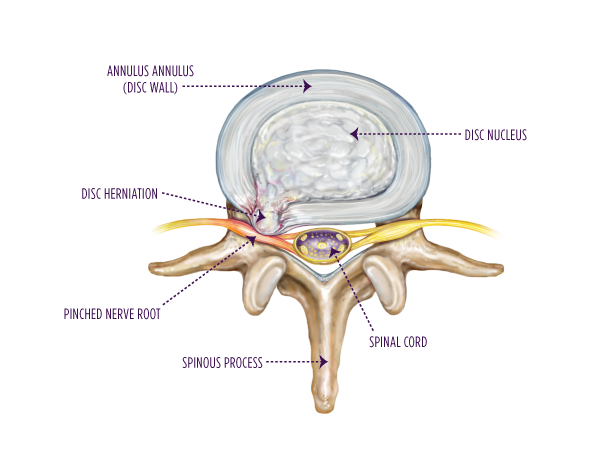

Each vertebra in the spine is separated by a disc. These discs are composed of a tough fibrous outer ring (annulus fibrosus) and a gel-like center (nucleus pulposus). Functioning much like shock absorber, they spread out the weight-bearing forces in the spine.
If the outer ring gets damaged, one of two things can happen:
How does a herniated disc happen?
As we age, our discs weaken. When this happens, repetitive stress or injury may cause damage to one or more discs. The gel center may then bulge out of the damaged fibrous ring and put pressure upon the spinal cord, nerves, or other sensitive tissues. When this happens, you may experience pain or symptoms such as weakness, numbness, or tingling.
What are the symptoms of a herniated disc?
- Early symptoms (when a disc is bulging, but before it herniates) can be somewhat vague. Many people report a generalized backache.
- When a disc herniates, the pain can be sudden and severe.
- You may experience severe shooting pains down an arm or leg.

How is a herniated disc diagnosed?
To diagnose a herniated disc, your physician will review your health history and perform a physical examination.
Your doctor may also recommend diagnostic imaging such as an X-ray, MRI, or CT scan. Electromyography (EMG) testing may also be used to assess nerve signals.
How are herniated discs treated nonsurgically?
Fortunately, despite the pain associated with a disc herniation, symptoms can often improve on their own with supportive treatments.
Nonsurgical treatment options for herniated discs include:
What are the surgical treatment options for herniated discs?
If conservative treatments are ineffective, surgery may be considered. Surgery is reserved only for the cases where everything else has been tried or the limb weakness is so severe that you cannot do the most basic of daily activities.
Surgical treatments for herniated discs include:
- Microdiscectomy
- Disc replacement surgery
- Anterior cervical discectomy with fusion (ACDF)
- Decompression surgeries, including laminectomy and foraminotomy
Microdiscectomy
The most common surgery for herniated discs is called a “microdiscectomy.” In this surgery, a one- to two-inch incision is made in your spine on the side of the herniation. The surgeon then finds the herniation and cuts it out. The surgery usually lasts about one to two hours, and many people feel better right upon waking up.
Disc replacement surgery
Disc replacement is most effective when the source of the pain is contained in the disc and the disc alone, and when the patient meets other qualifications, including a healthy weight, no prior major spine surgery, and no deformity in the spine.
More resources on disc replacement surgery:
- Read the article: Benefits of Cervical Disc Replacement
Cervical discectomy and fusion
Anterior cervical discectomy with fusion is a surgical procedure that involves relieving the pressure placed on nerve roots and/or the spinal cord by a herniated disc or bone spurs in the neck.
How is an ACDF performed?
Through a small incision made near the front of the neck, the surgeon:
- Removes the intervertebral disc to access the compressed nerves
- Relieves the pressure by removing its source
- Places a bone graft between the two vertebrae
- In some cases, adds metal plates or pins that will provide extra support and stability to help ensure proper fusion.
Learn more about anterior cervical discectomy and fusion.
Laminectomy
The goal of laminectomy is to relieve the pressure on the spinal nerves that is causing your symptoms.
How laminectomy works:
- Your orthopedic surgeon will make an incision near the center of your spine between two and six inches long.
- Through this incision, any bone spurs and damaged disc material are removed.
- Then, the incision is closed with sutures.
- As you heal in the weeks following surgery, the muscles and ligaments of the back will fill in the space where the lamina used to be.
Foraminotomy
A foraminotomy is another kind of decompression surgery that aims to reduce the pressure on your spinal nerves. The surgeon makes more room for the nerves by enlarging the opening the nerves travel through on their way out of the spinal canal.
Summit Orthopedics offers comprehensive spine expertise
Summit’s spine care team is recognized by the National Committee for Quality Assurance for the comprehensive expertise of our patient-centered care. Our back specialists diagnose spine problems and design custom treatment plans built on a conservative, nonsurgical approach. Most patients find relief through treatments including guided injections, specialized physical therapy, biofeedback, exercise, activity modification, and medication. When conservative care does not relieve symptoms, our highly skilled surgeons offer proven, evidence-based surgical options. Together with you, we will determine the right course of action.
Start your journey to a healthy spine. Find your spine expert, request an appointment online, or call us at (651) 968–5201 to schedule a spine consultation.
Summit has convenient locations across the Minneapolis-St. Paul metro area, serving Minnesota and western Wisconsin. We have state-of-the-art centers for comprehensive orthopedic care in Eagan, MN, Vadnais Heights, MN, and Woodbury, MN, as well as additional community clinics throughout the metro and southern Minnesota.
